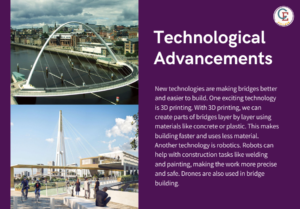Bridges are structures built to span physical obstacles like rivers, valleys, or roads. They play a crucial role in connecting people and places, making travel and transport easier. In the past, people built bridges using materials like stone, wood, and steel. Stone bridges are very strong and can last a long time. Wooden bridges are easier to build and were used a lot in olden days. Steel bridges are tough and can support heavy loads.
These materials were the building blocks of early bridges and helped connect people and places for many years. Throughout history, bridges have evolved from simple wooden structures to complex marvels of engineering. Today, with growing urbanization and Advances in Bridge Design and Construction, there is a need for innovative bridge designs that are not only functional but also sustainable and resilient.
Materials and Techniques
Traditional Materials
In the past, people used simple materials like stone, wood, and steel to build bridges. Stone was one of the first materials used because it is very strong and can last for hundreds of years. People stacked stones together to create strong, arch-shaped bridges that could hold a lot of weight. Wooden bridges were also common because wood was easy to find and work with. These bridges were lighter than stone bridges and quicker to build, but they didn’t last as long because wood can rot or catch fire.
Later, steel became a popular material for building bridges. Steel is very strong and flexible, which makes it perfect for supporting heavy loads and spanning long distances. Steel bridges could be built taller and longer than stone or wood bridges. These traditional materials laid the foundation for the bridges we see today, helping people and goods move more easily from one place to another.
Modern Materials
Today, we use new and improved materials to build bridges, making them stronger and longer-lasting. One of the most important materials is reinforced concrete. It combines concrete, which is good at handling pressure, with steel bars inside, which are good at handling tension. This combination makes bridges very strong and durable. Another modern material is carbon fiber.
It is very light but also very strong, so it can be used to build parts of bridges that need to be both strong and lightweight. Engineers are also using smart materials that can change their properties when needed.
For example, some materials can change shape or strength when the temperature changes, helping the bridge adapt to different conditions. These modern materials are making bridges safer and helping them last longer, even in tough weather conditions. They also allow engineers to create more interesting and beautiful bridge designs that can be built faster and with less impact on the environment.
Construction Techniques
The evolution of bridge construction techniques has led to various designs. Simple beam bridges, where a horizontal beam is supported at each end, are common for short spans. Suspension bridges, with cables supporting the roadway, allow for longer spans and have become iconic structures worldwide.
Advances in Bridge Design and Construction
New technologies are making bridges better and easier to build. One exciting technology is 3D printing. With 3D printing, we can create parts of bridges layer by layer using materials like concrete or plastic. This makes building faster and uses less material. Another technology is robotics. Robots can help with construction tasks like welding and painting, making the work more precise and safe.
Drones are also used in bridge building. They fly around and take pictures or videos of the bridge, helping engineers check for problems without having to climb up high. Lastly, smart sensors are put into bridges to monitor their condition. These sensors can tell if a bridge is getting too stressed or if there are cracks forming.
This information helps engineers fix problems before they become serious. These technologies are making bridges stronger, safer, and longer-lasting. Let’s discuss more about this –
3D Printing – 3D printing is a way to make parts of a bridge by adding material layer by layer. It allows engineers to create complex shapes quickly and with less waste. This makes building bridges faster and more efficient.
Robotics – Robots are machines that can do jobs like welding and painting. They help build bridges with great accuracy and can do dangerous tasks safely, reducing the risk to human workers.
Drones – Drones are small flying devices with cameras. They are used to inspect bridges by taking pictures and videos from high and hard-to-reach places. This helps engineers check for any problems without having to climb up themselves.
Smart Sensors – Smart sensors are devices put into bridges to monitor their condition. They can detect changes in stress, temperature, and movement. This real-time information helps engineers find and fix problems early, keeping the bridge safe and in good condition.
Sustainable Practices
Sustainable practices in building bridges focus on doing things in ways that are good for the environment and for saving resources. This includes using materials that don’t harm the environment, like recycled steel and concrete.
These materials help reduce waste and pollution. It also means making bridges strong so they last a long time without needing lots of repairs. Adding things like solar panels on bridges to make renewable energy is another way to be sustainable.
Making bridges that people can walk or bike across helps cut down on using cars, which is good for the environment too. Lastly, building bridges in ways that don’t disturb nature, like animals and water, is important for keeping our ecosystems healthy. These sustainable practices help make sure bridges are good for the environment and for people for a long time.
Case Studies
Millau Viaduct, France
The Millau Viaduct is the tallest bridge in the world, standing at 343 meters (1,125 feet). This cable-stayed bridge spans the Tarn River Valley and is an engineering marvel known for its height and elegance.
The Golden Gate Bridge, USA
The Golden Gate Bridge, completed in 1937, is one of the most iconic suspension bridges. It spans the Golden Gate Strait, connecting San Francisco to Marin County, and is renowned for its stunning design and engineering.
The Helix Bridge, Singapore
The Helix Bridge is a pedestrian bridge that resembles a double helix structure. This unique design combines aesthetics with functionality, providing a safe and visually appealing walkway.
The 3D-Printed Bridge, The Netherlands
The world’s first 3D-printed bridge, located in Amsterdam, demonstrates the potential of 3D printing technology in construction. Made of reinforced concrete, this bridge is a testament to innovative engineering.
Challenges and Future Directions
Environmental Concerns
Building bridges can impact the environment, affecting ecosystems and wildlife. Engineers must balance development with environmental preservation, using sustainable practices to minimize harm.
Cost and Budget Constraints
Bridge construction can be expensive, with costs influenced by materials, labor, and design complexity. Engineers must find ways to optimize costs without compromising quality and safety.
Future Innovations
The future of bridge design and construction lies in continued innovation. Advances in materials, construction techniques, and technology will lead to stronger, more efficient, and sustainable bridges.
In summary, bridges are vital structures that connect communities and facilitate transportation. The evolution of bridge design and construction has led to remarkable advancements in materials, technology, and sustainability. As we look to the future, continuous innovation will be essential in building bridges that are not only functional but also resilient and eco-friendly.
Feel free to follow us there on Instagram and drop a comment to say hello!



